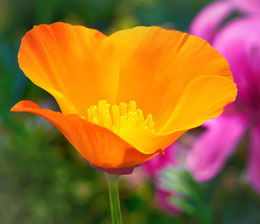The California poppy, with its bright and sun-kissed color, can have quite a dizzy effect. It also has excellent medicinal properties. Read on to know more about this flower.
 Where flowers bloom, so does hope
Where flowers bloom, so does hope ― Claudia Alta Taylor Johnson, First Lady of the United States (1963-1969)
This is exactly what a flower to me is; hope of a new beginning, even when it fades away. It fades away only to bloom again. Of all the beautiful flowers, a bed of California poppies can be quite captivating.
History
The scientific name for the California poppy is
Eschscholzia californica, named after Johann Friedrich von Eschscholtz, a Baltic German botanist. In 1890, the California State Floral Society selected this flower as its state flower. April 6 is celebrated as the California Poppy Day. Spanish explorers named the poppy as
Copa de Oro, or the Cup of Gold. The Indians often told the tale of poppy blooms depositing gold in the earth. Owing to this golden connection, the California poppy symbolizes wealth and success.
Habitat
This is a spring flower that requires a sunny and open spot to grow. It can also grow in sandy places and rocky areas. These flowers are most common in California and also in Southern Washington, Nevada, New Mexico, and Northwest Baja. It can now be grown in any garden, anywhere in the world. Seeds are easily available in shades of yellow and orange, with dashes of red.
Growing
Seeds of California poppy can be sowed bi-annually, in autumn and spring, for continuous showing in early summer and late spring. Soil must be well prepared and the pH balance should be maintained at neutral. Seeds can be directly sowed or thinned later. Sow the seeds 0.25 cm deep in the soil. Keep the moist and cover it. The cover should be removed as soon as the saplings sprout. Inadequate sunlight would result in either the death of the sapling or poor flower show. Transplant at a four-leaf stage. Feed it with liquid manure when the buds first appear. These plants are mostly insect and pest-resistant.
Flower Description
These flowers have a bright sun-kissed orange color, hence they are also known as golden poppies. They are generally four-petaled. They bloom completely when it is sunny and close at night or on cloudy days. The flower stem is usually 5 to 20 inches tall, and the seeds are found in the center of the flower. Insects are the main pollinators for California poppies.
Uses
The plant, root, flower, and seeds of the California poppy are used for their therapeutic medicinal purposes. Unlike the red poppy, this variety is milder in its sedating properties, is analgesic, and has antispasmodic properties too. It is dried and used to prepare diffusions, tinctures, and powder. Following is the list of its uses:
- It helps to normalize psychological function without depressing the central nervous system.
- It treats insomnia, anxiety, and bed-wetting in children.
- It helps in treating behavioral disorders, such as ADD and ADHD, in children and young adults.
- The treatment method that uses the California poppy essence to treat learning disabilities, like dyslexia, in children is a widely accepted treatment.
- These flowers help relieve toothache.
- They are a remedy for high fever, rapid pulse, and persistent spasmodic cough.
- They help to contain head lice.
- The tincture is used to treats cuts and scrapes.
California poppy flower arrangement can liven up the dullest corner with its golden hues. A mix of other colors and varieties can also be added, as per the requirement. The Antelope Valley California Poppy Reserve is located 15 miles west of Lancaster, California. The park offers free guided public tours daily. Another place worth a visit is the California Poppies at Morro Bay State Park.






 Where flowers bloom, so does hope ― Claudia Alta Taylor Johnson, First Lady of the United States (1963-1969)
Where flowers bloom, so does hope ― Claudia Alta Taylor Johnson, First Lady of the United States (1963-1969)